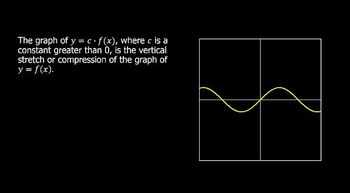Table of contents
- 0. Review of Algebra4h 16m
- 1. Equations & Inequalities3h 18m
- 2. Graphs of Equations43m
- 3. Functions2h 17m
- 4. Polynomial Functions1h 44m
- 5. Rational Functions1h 23m
- 6. Exponential & Logarithmic Functions2h 28m
- 7. Systems of Equations & Matrices4h 6m
- 8. Conic Sections2h 23m
- 9. Sequences, Series, & Induction1h 19m
- 10. Combinatorics & Probability1h 45m
3. Functions
Transformations
Problem 39a
Textbook Question
Plot each point, and then plot the points that are symmetric to the given point with respect to the (a) x-axis, (b) y-axis, and (c) origin. (5, -3)
 Verified step by step guidance
Verified step by step guidance1
Step 1: Start by plotting the given point (5, -3) on the Cartesian plane. This point is located 5 units to the right of the origin along the x-axis and 3 units below the origin along the y-axis.
Step 2: To find the point that is symmetric to (5, -3) with respect to the x-axis, you need to change the sign of the y-coordinate while keeping the x-coordinate the same. This gives you the point (5, 3). Plot this point on the same Cartesian plane.
Step 3: To find the point that is symmetric to (5, -3) with respect to the y-axis, you need to change the sign of the x-coordinate while keeping the y-coordinate the same. This gives you the point (-5, -3). Plot this point on the same Cartesian plane.
Step 4: To find the point that is symmetric to (5, -3) with respect to the origin, you need to change the signs of both the x-coordinate and the y-coordinate. This gives you the point (-5, 3). Plot this point on the same Cartesian plane.
Step 5: Now you have plotted the original point and its three symmetric points with respect to the x-axis, y-axis, and the origin. This will give you a visual representation of how these symmetries work in the Cartesian plane.
Recommended similar problem, with video answer:
 Verified Solution
Verified SolutionThis video solution was recommended by our tutors as helpful for the problem above
Video duration:
5mPlay a video:
Was this helpful?
Key Concepts
Here are the essential concepts you must grasp in order to answer the question correctly.
Symmetry with respect to the x-axis
A point (x, y) is symmetric to the x-axis if its reflection across the x-axis is (x, -y). This means that the x-coordinate remains the same while the y-coordinate changes sign. For example, the point (5, -3) would have its symmetric point with respect to the x-axis at (5, 3).
Recommended video:

Properties of Parabolas
Symmetry with respect to the y-axis
A point (x, y) is symmetric to the y-axis if its reflection across the y-axis is (-x, y). In this case, the y-coordinate remains unchanged while the x-coordinate changes sign. For the point (5, -3), the symmetric point with respect to the y-axis would be (-5, -3).
Recommended video:

Properties of Parabolas
Symmetry with respect to the origin
A point (x, y) is symmetric to the origin if its reflection across the origin is (-x, -y). This transformation involves changing the signs of both coordinates. For the point (5, -3), the symmetric point with respect to the origin would be (-5, 3).
Recommended video:

Graph Hyperbolas NOT at the Origin

 5:25m
5:25mWatch next
Master Intro to Transformations with a bite sized video explanation from Nick Kaneko
Start learningRelated Videos
Related Practice


























